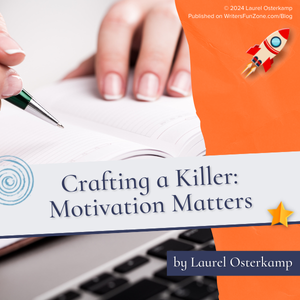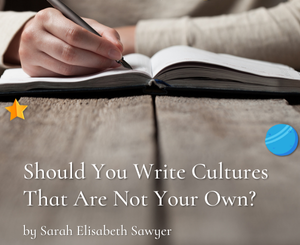Crafting a Killer: Motivation Matters by Laurel Osterkamp
 Let’s welcome back Laurel Osterkamp as she shares with us “Crafting a Killer: Motivation Matters.” Enjoy!
Let’s welcome back Laurel Osterkamp as she shares with us “Crafting a Killer: Motivation Matters.” Enjoy!
***
The other day I Googled, “Best way to poison someone.”
Instantly, I wondered what damage I’d done to my digital footprint. Will whoever’s in charge of the internet think I’m a killer? Will they understand that while I’d never murder anyone, I can’t say the same for all of the characters I craft?
But that’s where the real problem comes in.
Truth is, I don’t have a ton of experience crafting killers. But my current WIP requires me to make at least one of my main characters a murderer.
How do I figure out their identity and motivation?
Why are they committing such dastardly deeds?
(Hint: The answer cannot simply be because they’re insane, evil, or evil and insane.)
So, how do you create a villain that’s believable? Here’s how I plan to go about it. Unfortunately, (or maybe fortunately for my search history) it’s not something I can Google.
The Steps to Create a Believable Villain
The Villain’s Past
First, I’ll delve into the depths of the villain’s past.
A believable villain isn’t born from the ether, sprung fully-formed with an intent to do harm. No, they are a product of their circumstances, sculpted by the rough hands of life.
For instance, consider the notorious Hannibal Lecter. Hannibal did not take pleasure in savagery for savagery’s sake; his past held dark secrets that steered him towards his monstrous path. There was a reason, a root cause — albeit disturbing — that gave birth to the villain he became and his taste for human flesh.
Human Traits
Secondly, I’ll give my villain human traits.
Despite their evil deeds, they must bear qualities that we can empathize with or relate to.
In J.K. Rowling’s Harry Potter series, Voldemort is not a symbol of unadulterated evil without any redeeming qualities. He is shown as a profoundly lonely individual who fears death above all things. His fear of death makes him human, even if his actions are undoubtedly monstrous.
Their Unbreakable Rules and Codes
Third, my villain will follow a unique set of rules and codes that they won’t break for anything.
These rules help add depth to their character and make them predictable in their unpredictability.
The Joker from Christopher Nolan’s Dark Knight Trilogy serves as an excellent example here. This agent of chaos lived by his principle of upending societal order; it was not personal vendetta but an anarchic worldview that drove him.
Smarter Than the Proragonist
Fourth, my villains should be intelligent and cunning — two steps ahead of the protagonist always!
Take Amy Dunne from Gillian Flynn’s Gone Girl as the perfect embodiment of this trait. Precise and meticulous in her manipulation, she is always one step ahead not only of her husband Nick but also the audience, making her a highly engaging and believable antagonist.
Hero of their own Story
Finally–and perhaps most importantly–I’ll remember that no villain believes themselves to be evil; they think they’re the hero of their own story, fighting for what they perceive is right.
Take Thanos from Marvel’s Infinity War. He genuinely believes in his cause of balancing the universe, even if it means half of its population must die. To him, he is not the villain but a necessary force of change.
Bringing It All Together
By weaving these essential elements together — a troubled past, humanizing traits, personal code, intelligence, and self-justification — you create a villain that does more than just carry out evil deeds.
This villain becomes a fully-fledged character, as alive and psychologically complex as your protagonist.
A believable villain can transform a simple story into an intriguing battle of philosophies and wits, keeping your readers hooked till the very last page.
***
About the Author
 Laurel Osterkamp is from Minneapolis, where she teaches and writes like it’s going out of style.
Laurel Osterkamp is from Minneapolis, where she teaches and writes like it’s going out of style.
She’s lost count of her novels, and her short fiction has been featured in Abandon Journal, Idle Ink, Tangled Locks Literary Journal, Bright Flash Literary Journal, and The Metawoker, among other places. Her newest novel, The Side Project, will be released in November by The Wild Rose Press. Ramona Quimby is her spirit animal.
Social Media:
Website – https://laurellit.com
Facebook – https://www.facebook.com/authorlaurelosterkamp
BookBub – https://www.bookbub.com/profile/laurel-osterkamp
Instagram: Laurel Osterkamp (@laurel_osterkamp) • Instagram photos and videos
***
Want an entire course on crafting your villain?
Then check out “How to Build an Epic Rivalry Between Your Hero and Your Villain.”
More resources on crafting a great villain to writ a compelling story.






